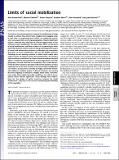| dc.contributor.author | Pentland, Alex Paul | |
| dc.contributor.author | Rutherford, Alex | |
| dc.contributor.author | Cebrian, Manuel | |
| dc.contributor.author | Dsouza, Sohan | |
| dc.contributor.author | Moro, Esteban | |
| dc.contributor.author | Rahwan, Iyad | |
| dc.date.accessioned | 2013-12-30T16:08:05Z | |
| dc.date.available | 2013-12-30T16:08:05Z | |
| dc.date.issued | 2013-04 | |
| dc.date.submitted | 2012-09 | |
| dc.identifier.issn | 0027-8424 | |
| dc.identifier.issn | 1091-6490 | |
| dc.identifier.uri | http://hdl.handle.net/1721.1/83359 | |
| dc.description.abstract | The Internet and social media have enabled the mobilization of large crowds to achieve time-critical feats, ranging from mapping crises in real time, to organizing mass rallies, to conducting search-and-rescue operations over large geographies. Despite significant success, selection bias may lead to inflated expectations of the efficacy of social mobilization for these tasks. What are the limits of social mobilization, and how reliable is it in operating at these limits? We build on recent results on the spatiotemporal structure of social and information networks to elucidate the constraints they pose on social mobilization. We use the DARPA Network Challenge as our working scenario, in which social media were used to locate 10 balloons across the United States. We conduct high-resolution simulations for referral-based crowdsourcing and obtain a statistical characterization of the population recruited, geography covered, and time to completion. Our results demonstrate that the outcome is plausible without the presence of mass media but lies at the limit of what time-critical social mobilization can achieve. Success relies critically on highly connected individuals willing to mobilize people in distant locations, overcoming the local trapping of diffusion in highly dense areas. However, even under these highly favorable conditions, the risk of unsuccessful search remains significant. These findings have implications for the design of better incentive schemes for social mobilization. They also call for caution in estimating the reliability of this capability. | en_US |
| dc.language.iso | en_US | |
| dc.publisher | National Academy of Sciences (U.S.) | en_US |
| dc.relation.isversionof | http://dx.doi.org/10.1073/pnas.1216338110 | en_US |
| dc.rights | Article is made available in accordance with the publisher's policy and may be subject to US copyright law. Please refer to the publisher's site for terms of use. | en_US |
| dc.source | PNAS | en_US |
| dc.title | Limits of social mobilization | en_US |
| dc.type | Article | en_US |
| dc.identifier.citation | Rutherford, A., M. Cebrian, S. Dsouza, E. Moro, A. Pentland, and I. Rahwan. “Limits of social mobilization.” Proceedings of the National Academy of Sciences 110, no. 16 (April 16, 2013): 6281-6286. | en_US |
| dc.contributor.department | Massachusetts Institute of Technology. Media Laboratory | en_US |
| dc.contributor.department | Program in Media Arts and Sciences (Massachusetts Institute of Technology) | en_US |
| dc.contributor.mitauthor | Pentland, Alex Paul | en_US |
| dc.relation.journal | Proceedings of the National Academy of Sciences | en_US |
| dc.eprint.version | Final published version | en_US |
| dc.type.uri | http://purl.org/eprint/type/JournalArticle | en_US |
| eprint.status | http://purl.org/eprint/status/PeerReviewed | en_US |
| dspace.orderedauthors | Rutherford, A.; Cebrian, M.; Dsouza, S.; Moro, E.; Pentland, A.; Rahwan, I. | en_US |
| dc.identifier.orcid | https://orcid.org/0000-0002-8053-9983 | |
| mit.license | PUBLISHER_POLICY | en_US |
| mit.metadata.status | Complete | |
